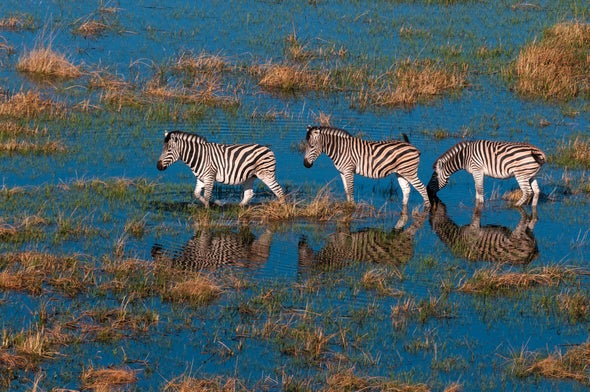[해외 DS] AI, 생물 다양성 보전에 ‘게임 체인저’
다양성 보전에 효과적이지만 인간 전문가와 협력 필요 종 식별과 모니터링 및 예측 모두 인공지능 기술 활용 계산 비용 크기 때문에 적절한 환경 영향 제한 있어야
[해외DS]는 해외 유수의 데이터 사이언스 전문지들에서 전하는 업계 전문가들의 의견을 담았습니다. 저희 데이터 사이언스 경영 연구소 (GIAI R&D Korea)에서 영어 원문 공개 조건으로 콘텐츠 제휴가 진행 중입니다.

점점 더 많은 연구자가 생물 다양성을 모니터링하고 멸종 위기에 처한 종을 돕기 위한 노력을 강화하기 위해 인공지능을 활용하는 추세가 확연해지고 있다. 이는 생태계를 교란하거나 상당한 시간과 노동력, 자원이 필요한 기존 방법과 달리, AI는 방대한 양의 데이터를 빠르고 효과적으로 분석할 수 있는 잠재력을 지니고 있기 때문이다.
영국 리버풀에 본사를 두고 다양한 생태학 프로젝트에 AI 기술을 사용하는 비영리 단체인 Conservation AI에서 머신러닝을 연구하는 칼 찰머스는 “AI 없이는 멸종 위기종을 보호하려는 유엔의 목표를 결코 달성할 수 없을 것”이라고 말한다.
현재 수백만 년 전에 비해 수백에서 수천 배 빠른 속도로 생물종이 사라지고 있으며, 최대 100만 종의 생물이 멸종 위기에 처해 있다. 유엔은 이에 대응하여 2020년까지 지구 육지와 해양의 최소 30%를 보호하겠다는 목표를 세웠다.
The Future Society의 설립자 니콜라스 미아일레(Nicolas Miailhe)는 AI가 불완전하지만, 중요한 발견을 가속할 수 있다고 말했다. 그는 “모델을 설계하고 데이터를 수집, 라벨링, 품질 검사 및 해석하는 데는 인간 전문가가 필요합니다”라고 말했다.
열대 우림 소리로 생물 다양성 측정
독일 뷔르츠부르크 대학의 생태학자 요르그 뮐러(Jörg Müller)와 그의 동료들은 AI 도구를 활용하여 오디오 녹음에서 동물 종을 식별하여 열대 우림의 생물 다양성을 정량화하는 데 도움이 될 수 있음을 보여줬다. 10월 17일 네이처 커뮤니케이션에 게재된 연구에서 연구진은 AI를 사용하여 종 다양성이 풍부한 것으로 알려진 에콰도르 초코 지역의 동물 ‘사운드스케이프’를 분석했다. 연구진은 삼림 벌채로 훼손되지 않은 숲, 회복 중인 지역, 카카오 농장과 목초지로 활발하게 사용되는 삼림 벌채지 등 43개 부지에서 녹음기를 설치했다. 전문가들은 오디오 파일로 조류 183종, 양서류 41종, 포유류 3종을 식별할 수 있었다.
또한 연구진은 새소리를 식별하기 위해 이미 개발된 콘볼루션 신경망(CNN)이라는 일종의 AI 모델에 녹음 내용을 입력했습니다. CNN은 전문가들이 보유한 조류 중 75종을 골라낼 수 있었지만, 이 모델의 데이터 세트는 제한적이어서 이 지역에서 발생할 수 있는 조류 77종만 포함했다. 뮐러는 “우리의 연구 결과는 AI가 열대 지방에서 소리를 통해 더욱 포괄적인 종을 식별할 준비가 되었음을 보여줍니다.”라고 말했다. “이제 필요한 것은 인간이 수집한 더 많은 훈련 데이터뿐입니다.”
연구팀은 재생된 숲의 생물다양성을 정확하게 측정하기 위해 AI를 사용하는 것이 지속적인 자금 확보를 위해 성공을 입증해야 하는 생물다양성 프로젝트를 평가하는 데 중요할 수 있다고 전했다.
야생동물 식별 및 추적 자동화
Conservation AI의 연구원들은 드론이나 카메라 트랩의 영상과 이미지를 분석하여 멸종 위기에 처한 종을 포함한 야생동물을 식별하고 동물의 움직임을 추적하는 모델을 개발했다. 이들은 승인된 사용자가 영상과 데이터를 업로드하고 자동으로 분석하는 온라인 플랫폼을 구축하였으며, 관심 동물 발견 시 알림을 받을 수 있는 시스템도 도입했다.

지금까지 Conservation AI는 우간다의 멸종 위기에 처한 천산갑, 가봉의 고릴라, 말레이시아의 오랑우탄 등 68종에 걸쳐 1,250만 개 이상의 이미지를 처리하고 400만 개 이상의 개별 동물 출현을 감지했다. 자동화된 시스템 덕분에 밀렵이나화재와 같은 갑작스러운 위협으로부터 취약한 종을 신속하게 보호할 수 있게 됐다. Conservation AI는 이미 실시간으로 영상을 분석하여 천산갑 밀렵꾼을 적발한 바 있다.
생물 다양성 손실 원인 규명 및 예측에 활용
AI는 생물 다양성을 실시간으로 모니터링할 뿐만 아니라 인간 활동이 생태계에 미치는 영향을 모델링하고 역사적 변화를 재구성하는 데에도 사용할 수 있음이 밝혀졌다. 연구자들은 한 세기에 걸친 담수 생태계의 환경 파괴가 어떻게 생물 다양성 손실로 이어졌는지 알아내기 위해 AI를 사용했다.
인간 활동이 강과 호수의 생물 다양성 손실을 초래했다는 사실은 잘 알려졌지만, 어떤 환경 요인이 가장 큰 영향을 미치는지는 알려진 바가 거의 없다. 영국 버밍엄 대학교에서 진화 생물 시스템을 연구하는 루이사 오르시니(Luisa Orsini)와 그녀의 동료들은 AI를 사용하여 생물 다양성을 역사적 환경 변화와 연결하는 모델을 개발했다. 해당 모델은 지난 세기 동안 호수 퇴적물에 남은 유전 물질을 분석하여 살충제와 살균제가 이상기온 현상 및 강수량과 함께 생물 다양성 손실의 최대 90%를 설명할 수 있다는 사실을 발견했다.
인공지능은 과거 데이터를 학습하여 미래의 생물 다양성을 예측하는 데 중요한 도구로 활용될 전망이지만, 그에 따른 환경적 영향 평가와 적절한 관리가 필수적이다. 결국 AI가 물질적 자원을 소비하기 때문에 궁극적으로 생태계에 악영향을 미칠 수 있다. 따라서 전문가들은 보존 역량을 강화할 수 있다는 가능성과 함께 AI 사용의 환경 영향 평가가 중요하다는 점을 강조하고 있다.
How AI Can Help Save Endangered Species
Scientists are using artificial intelligence to fight biodiversity loss by analysing vast amounts of data, monitoring ecosystems and spotting trends over time
An increasing number of researchers is turning to artificial intelligence (AI) to monitor biodiversity and bolster efforts to help endangered species. Unlike conventional methods that can disrupt ecosystems or require considerable time, labour and resources, AI has the potential to quickly and effectively analyse vast quantities of real-world data.
“Without AI, we’re never going to achieve the UN’s targets for protecting endangered species,” says Carl Chalmers, who studies machine learning at Conservation AI, a UK-based non-profit organization in Liverpool that uses AI technology for various ecology projects.
Species are vanishing at a rate hundreds to thousands of times faster than that millions of years ago, with up to one million species on the brink of extinction. In response, the United Nations set a goal in 2020 to safeguard at least 30% of Earth’s land and oceans by the end of the decade.
AI is “imperfect” but could accelerate important discoveries, says Nicolas Miailhe, Paris-based founder of The Future Society, an international non-profit organization that aims to better govern AI. “We very much need human practitioners in the loop to design models, as well as collect, label, quality check and interpret data,” he says.
SOUNDSCAPE ANALYSIS
Ecologist Jörg Müller at the University of Würzburg, Germany, and his colleagues have shown that AI tools can help to quantify biodiversity in tropical forests by identifying animal species from audio recordings.
In a study published on 17 October in Nature Communications, the researchers used AI to analyse animal ‘soundscapes’ in the Chocó, a region in Ecuador known for its rich species diversity. They placed recorders in 43 plots of land representing different stages of recovery: forests that were untouched by deforestation, areas that had been cleared but then abandoned and had started to regrow, and deforested land actively used for cacao plantations and pasture. They gave the audio files to experts, who were able to identify 183 bird, 41 amphibian and 3 mammalian species.
The researchers also fed their recordings to a type of AI model called a convolutional neural network (CNN), which had already been developed to identify bird sounds. The CNN was able to pick out 75 of the bird species that the experts had, but the model’s data set was limited and contained only 77 bird species that might occur in the region. “Our results demonstrate that AI is ready for more comprehensive species identification in the tropics from sound,” says Müller. “All that is needed now is more training data collected by humans.”
The team says that using AI to precisely measure the biodiversity of regenerated forests could be crucial for evaluating biodiversity projects that must demonstrate success to secure continued funding.
CAMERA-TRAP FOOTAGE
Researchers at Conservation AI have developed models that can scour through footage and images from drones or camera traps to identify wildlife — including critically endangered species — and track animal movements.
They built a free online platform that uses the technology to automatically analyse images, video or audio files, including data from real-time camera-trap footage and other sensors that approved users can upload. Users have the option to be notified by e-mail when a species of interest has been spotted in the footage they have uploaded.
So far, Conservation AI has processed more than 12.5 million images and detected more than 4 million individual animal appearances across 68 species, including endangered pangolins in Uganda, gorillas in Gabon and orangutans in Malaysia. “The platform can process tens of thousands of images an hour, in contrast to humans who can do a few thousand at best,” says Paul Fergus, one of Conservation AI’s lead researchers. “The speed at which AI processes data could allow conservationists to protect vulnerable species from sudden threats — such as poaching and fires — quickly,” he adds. Conservation AI has already caught a pangolin poacher in the act by analysing footage in real time.
As well as monitoring biodiversity in real time, AI can be used to model the impacts of human activities on an ecosystem and reconstruct historical changes. Researchers have used AI to discover how a century’s worth of environmental degradation in a freshwater ecosystem has led to biodiversity loss.
Although it is well documented that human activities have resulted in biodiversity loss in rivers and lakes, little is known about which environmental factors have the largest impact. “Long-term data is pivotal to link changes in biodiversity to environmental change and to define achievable conservation goals,” says Luisa Orsini, who studies evolutionary biosystems at the University of Birmingham, UK.
Orsini and her colleagues developed a model that links biodiversity to historical environmental changes using AI. In a study published in eLife earlier this year, the team obtained genetic material that had been left behind over the past century by plants, animals and bacteria in the sediment of a lake. The sediment layers were dated and environmental DNA was extracted for sequencing.
The scientists then combined these data with climate information from a weather station and chemical-pollution data from direct measurements and national surveys, using an AI designed to handle diverse types of information. Orsini says the aim was to identify correlations among the ‘mayhem’ of data.
They found that the presence of insecticides and fungicides, together with extreme-temperature events and precipitation, could explain up to 90% of the biodiversity loss in the lake. “Learning from the past, we showcased the value of AI-based approaches for understanding past drivers of biodiversity loss,” says study co-author Jiarui Zhou, who is also at the University of Birmingham.
The main benefit of using AI is that it is hypothesis free and data driven, says Orsini. “AI ‘learns’ from past data and predicts future trends in biodiversity with higher accuracy than ever achieved before.”
Miailhe is hopeful that AI can be routinely applied to real-world conservation efforts in the near future. “That’s clearly the way to go,” he says. But he warns that AI consumes computing power and material resources, which ultimately has adverse effects on ecosystems. “Environmental impact assessments should be at the centre of AI risk management,” he says.



























